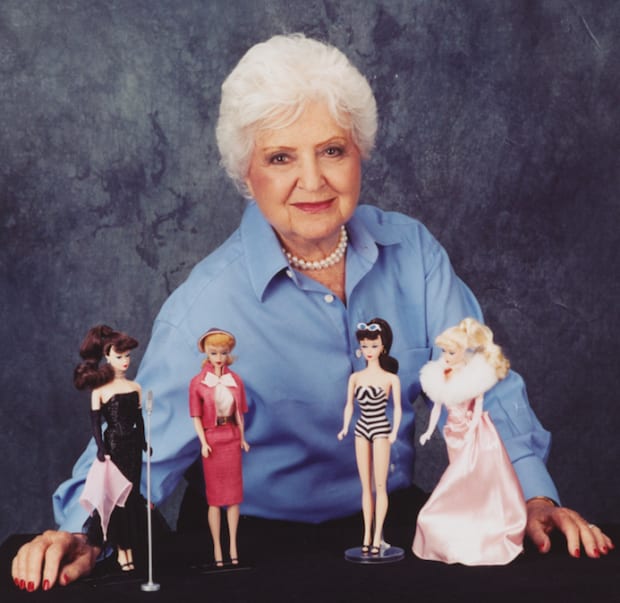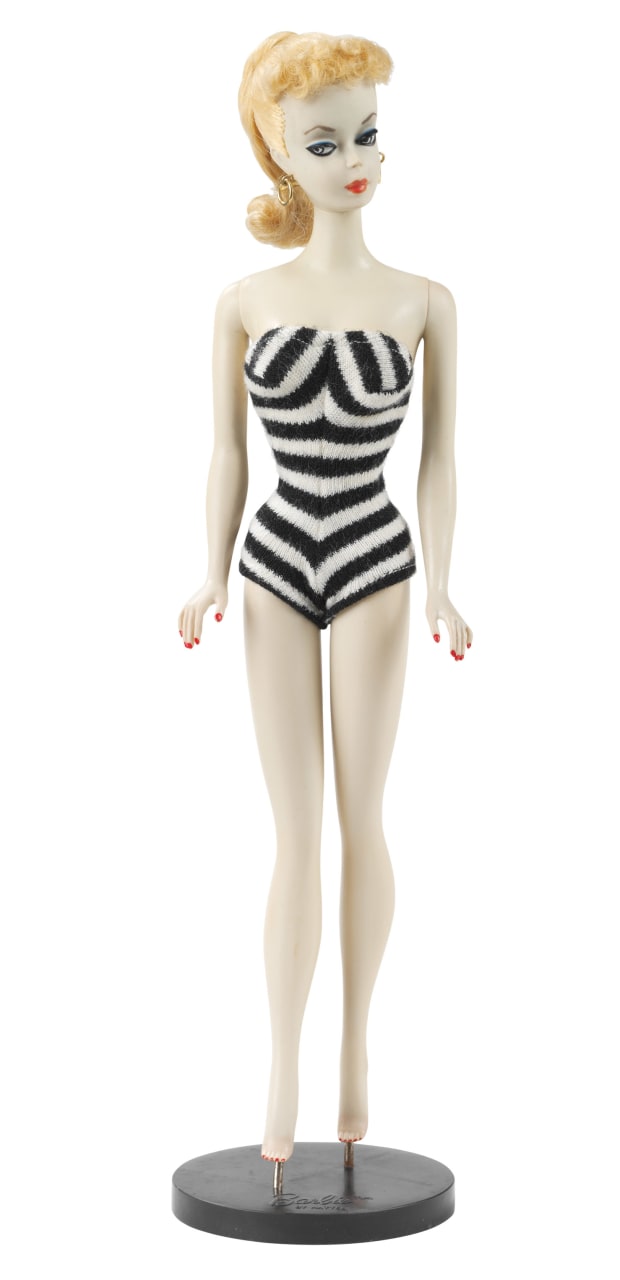#Amazing #Ruth #Handler #Woman #Barbie
Ruth Handler was confident and determined on the eve of the 1959 American International Toy Fair in New York.
As president of Mattel, a company founded by her husband Elliot – along with Harold “Matt” Matson, a friend of Elliot’s – in 1945, Handler was a dogged businessperson who trusted her instincts. Despite the naysayers in her own company, she was convinced her new doll, named after her daughter, Barbara, would be the hit of the show.

Image courtesy Schlesinger Library, Radcliffe Institute, Harvard University
Even so, Handler was an unlikely champion for the 11-1/2-inch, curvaceous Barbie doll. First off, Handler didn’t play with dolls as a little girl. As a matter of fact, she didn’t play with much at all.
“It’s not that I never played,” Handler wrote in her 1994 autobiography, Dream Doll: The Ruth Handler Story. “I did have a few close girlfriends and I enjoyed hanging around with them. But I was basically a loner. I rarely had lengthy phone conversations or sleepovers like the other kids did. I thought ‘girl talk’ was stupid.”

Image courtesy of the Schlesinger Library, Radcliffe Institute, Harvard University
Handler’s childhood, the one that shaped one of the most impressive careers in the toy industry, was anything but normal.
The youngest of 10 children of Polish immigrants, Handler was born on Nov. 14, 1916, in Denver. Her parents lived in Warsaw when it was occupied by Russia. Her father, Jacob Moskowicz – the name was shortened to Mosko when he arrived at Ellis Island in 1907 – was a blacksmith by trade.
Because he was skilled, her father was shipped to Denver, the center of the railroad industry, where blacksmiths were used for making and repairing train tracks. In 1908, Ida Mosko arrived in America with the couple’s six children, joining her husband in Colorado. Ida was 40 and ill when Ruth was born. There was no way for her mother to care for her youngest, so Ruth, only six months old, was taken in by her sister, Sarah, 20 years her elder.
Related Content: 10 Fun Facts About Barbie
For the next 19 years, Ruth lived with Sarah and her husband, Louie Greenwald. Sarah and Louie functioned as her parents, while her real parents were more like loving grandparents.
Handler grew up a tomboy and enjoyed the company of rough and tumble boys rather than girls. Dolls? Hardly. Besides, she enjoyed working, especially at the family’s drug store and soda fountain. It was there Handler developed her enthusiasm for business.
The idea of women working outside the home was not unusual for the family. In impoverished Poland, everyone worked to make ends meet. That work ethic traveled with the family to America. It would also serve Handler well when she launched one of the most successful toy companies in history.

Image courtesy of the Schlesinger Library, Radcliffe Institute, Harvard University.
Ruth met Elliot Handler at a dance when she was 16. He was an aspiring artist. The family didn’t approve of the idea of Ruth’s future chained to the fortunes of a starving artist. But love does what it does – it finds a way.
Ruth moved to Los Angeles, where she landed a job as a secretary at Paramount Pictures. Elliot followed her to California. They were married in 1938. The couple had two children, Barbara and Ken, names that soon would become familiar to millions of children worldwide
Elliot Handler was fascinated with new materials, especially an acrylic plastic called Lucite or Plexiglas that was being used in the defense industry. Elliot’s design abilities coupled with Ruth’s enthusiasm for sales formed the foundation of a potent team.
“I found that I loved the challenge of selling,” Handler wrote in Dream Girl. “Adrenaline surged through me whenever I walked into a store with samples and walked out with an order.”
The fledgling Mattel manufactured and sold plastic dollhouse furniture, and other toys, including a miniature plastic ukulele and a toy piano. Business was solid but it was about to get a whole lot better.
One day, while watching her daughter play make-believe with paper dolls, Ruth noticed Barbara pretending her dolls were college students, cheerleaders and adults with careers. Ruth was fascinated.

Antique Trader file photo
“Before Barbie was born, many dolls for young girls were of the baby doll variety, Kewpie dolls, diaper dolls, feeding dolls, those types of things,” said Sandi Holder, owner of Sandi Holder’s Doll Attic, a premier Barbie auction house, and author of Barbie: A Rare Beauty.
“Those dolls encouraged nurturing and motherhood and perpetuated the idea that a girl’s future was defined by being a mother and homemaker,” Holder said. “Barbie was born out of a desire to give girls something more.”
“My own philosophy of Barbie,” Handler wrote in her autobiography, “was that through the doll, the little girl could be anything she wanted to be. Barbie always represented the fact that a woman had choices.”
Perhaps because of her own childhood and a far different background than most, Handler was committed to filling a void she knew existed from watching her daughter play. It took three years to develop the first Barbie doll, which made its debut at the Toy Fair 61 years ago.

Antique Trader file photo
Handler was certain of a successful launch in New York, an event that featured more than 16,000 wholesale and retail buyers from stores worldwide. Barbie, in her black-and-white striped swimsuit, heels and sunglasses — and modest $3 retail price — was sure to be a hit. Handler just knew it.
Only she wasn’t.
A New York Times article previewing the Toy Fair said Mattel’s hottest item for the coming year was “a yard-long, two-stage plastic rocket which soars to about 200 feet.” The article also cited Mattel’s new toy guns. Only a couple of paragraphs were dedicated to the new Barbie doll.
Toy buyers were also unimpressed. About half of the buyers who saw her wanted nothing to do with the doll. Never before had they seen a doll so completely unlike the baby and toddler dolls popular at the time. Many were put off by the doll’s womanly figure. To say the least, they didn’t share Handler’s enthusiasm.
“Ruth, little girls want baby dolls,” one buyer said in a story recounted by Handler in her autobiography. “They want to pretend to be mothers.”
Handler was shaken. Her baby, as she described Barbie, had been rejected. But Handler was far from defeated.
“One of my strengths is that I do have the courage of my convictions and the guts to take a position, stand up for it, push for it, and make it happen,” Handler wrote in her autobiography. “I can be very persuasive in getting others to see the light.”

Image courtesy of the Schlesinger Library, Radcliffe Institute, Harvard University
Despite the cynics, Handler persisted. By sheer force of conviction, Barbie debuted. Mattel sold 300,000 dolls that first year. Outfits and accessories were sold separately. By the time Ken, Barbie’s boyfriend, made the scene in 1961, there was no stopping the teenage fashion model doll from becoming queen of the Toy World.
Although challenged by some for unrealistic beauty and her well-endowed physique, Barbie often opened little girls’ eyes to the potential of what might be. She was a college graduate in 1963 when few women attended college; she was a surgeon in 1973; a business executive in 1986; a summit diplomat and airline pilot in 1990; and a presidential candidate multiple times. Barbie was an astronaut in 1965, nearly 20 years before Sally Ride became America’s first woman in space aboard the shuttle Challenger in 1983.
Sixty years after her debut, it’s estimated that more than a billion Barbie dolls have been sold in more than 150 countries. Her appeal is worldwide.
“Ruth had a vision and when Ruth had a vision she was unstoppable,” Holder said. “Ruth didn’t pay any mind to a field dominated by men. In my opinion, Ruth dominated the field, not men.”
Handler helped run Mattel for 30 years, until she and her husband, then co-chair of the company, resigned in 1975. She survived breast cancer and embarked on a second career, starting a company that made prosthetic breasts for cancer survivors. She died in 2002.
Many of the big-bang explosions in politics, culture and technology of the 1960s were rooted in little bangs from the previous decade. In 1959, a confident and determined Ruth Handler, the woman behind Barbie, made a noise that still resonates today.
